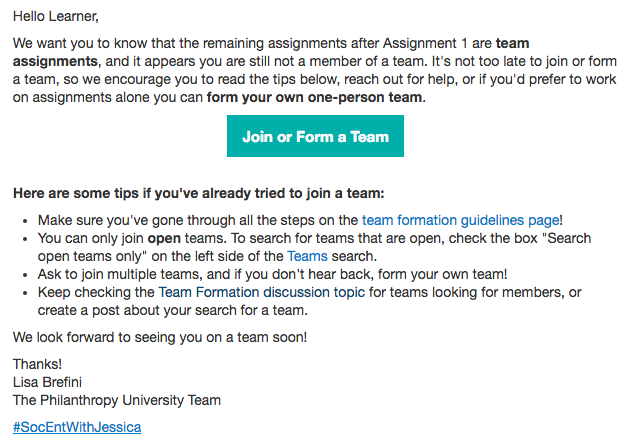3 Re-Engagement Email Strategy Tips for Learners in Your Online Courses

As a course progresses, it’s common for some learners to fall off track in terms of meeting deadlines, engaging with the course community, or even logging in. However, you should not assume that these learners won’t re-engage! Rather, you should make it easy for them to do so. Re-engage learners who need reminders or are falling behind the recommended pace of the course by sending them targeted intervention emails. Through using email segmentation (i.e. grouping your email recipients and tailoring the contents of your email based on learner behavior), you can reach out to learners who haven’t completed a certain task (e.g. submitted an assignment, joined a team, logged in recently) with a customized communication reminding them to complete that activity. This way, you can provide relevant information only to the appropriate audience, and more effectively re-engage the learners who are lagging behind. Below are examples of some email intervention use cases that that will help you re-engage your online learners.
Example of an email sent to learners who haven’t logged in to the course in the first week:
Subject: “3 Quick Ways to Get Started in the Course: Global Social Entrepreneurship” 
In cases where the activity is not required or has a soft deadline, it is important to avoid using stern language in your reminder. Remember that your learners are probably balancing multiple other professional and personal responsibilities outside of the course, so be sure to keep intervention emails short, use subject lines that are direct and attention-grabbing, and only include a single call-to-action in your email (even better: make it a button!). Be sure to have the email come from an individual, named person, so as to add a specialized and personalized feel. If possible (or applicable), you can even have it come from the course leader or instructor to further lend legitimacy and a personal touch. The goal when intervening is to create easy access points for learners to get back on track along the learning path. While some learners have fallen behind because they’re juggling other responsibilities, others are doing so because they may be confused about expectations and are in need of assistance. Many learners appreciate, or even depend on, such outreach efforts and reminders to complete tasks. But, don’t go overboard! It’s important to map out the expected trajectory of a learner through the course before the course begins, as well as to isolate one or two potential barriers to completion where learners might encounter difficulty (especially for those who are new to online learning). If your course will be utilizing teams, one potential friction point might be team formation. If there are assignments that are required to be done in teams, this is a critical juncture for learners, and you may want to reach out to learners who are late in joining teams with some tips to make it easier.
Subject: “Find Your Teammates–It’s Not Too Late!” 
Another potential barrier is submission of the first assignment. Whether it’s due to trouble meeting the deadline or a feeling that the difficulty level is too high, this is another common point at which some learners can tend to disengage. If there is a hard deadline for your assignment, consider sending out an email reminder a couple of days before it is due. If there is a soft deadline, in reaching out to learners who have missed the assignment, encourage them to check out classmates’ submissions or any feedback you have provided as a way for them to get inspired and on the right track.
Subject: “Assignment 1 Reminder” 
Once you’re about halfway through the course, it’s likely that learners who have stopped showing signs of activity despite your intervention emails may not be interested in the topic or the right fit for the course in general. At this point, it’s generally better to focus most of your energy on the learners who are engaged, and stop sending (or at least go a bit lighter on) the intervention emails.
Remember: intervention leads to retention. In addition to emails, interventions can also come in the form of direct messages in the platform or comments on a learner’s early assignments from Course Champions, TAs, or instructors asking questions or encouraging them to keep up the good work. No matter how you choose to do it, intervening and reaching out to learners who are falling behind will go a long way in re-engaging learners and getting more of them to complete the course and achieve their learning objectives.
Blog
In a Harvard Business School case study titled Creating a virtual internship at Goldman Sachs, the authors describe how The Goldman Sachs Group successfully transitioned a program serving thousands of interns into one that became entirely virtual.
Blog
Craig Weiss of The Craig Weiss Group, renowned for his expertise in learning technology, e-learning and AI in the workplace, spoke about AI In L&D: Roles, Risks, and Opportunities.
Blog
For Marriott, emerging from the pandemic presented a key opportunity to take stock and strategize how to improve worker retention and customer service — and the hospitality chain recognized that cultivating the best possible leaders was essential for navigating the changing landscape.
Blog
Learning management is a perennial challenge for L&D teams. Despite the emergence of more sophisticated learning and business analytics techniques, struggles with learning measurement persist at frustrating levels. Closing the gap between the boardroom and L&D around actual business or organizational impact is a required skill for learning leaders to master.
Blog
A social learning platform activates the deep and continual skill development needed for enduring behavior change in the context of modern business.
Blog
NovoEd enables executive education providers to build online learning experiences for custom executive education programs, open enrollment courses, and more.